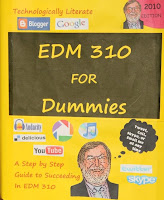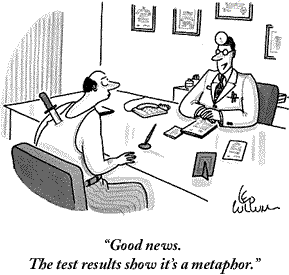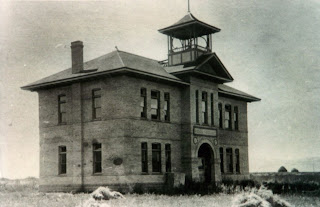Nicole Wilson's EDM310 Class Blog
Wednesday, May 4, 2011
Friday, April 29, 2011
Project # 16
To my group; You guys did a wonderful job, and I have absolutely enjoyed working with each and every one of you this semester. Michael, you did a wonderful job putting this project together. You have been a great team leader throughout the semester! Good Luck to all as you continue your journeys!
Final Report on PLN
 My PLN hasn't really changed very much since my previous post. As I anticipated, I have added more to my Google Bookmarks. I also feel that I have delved deeper into using Google Docs. My group has used Google Docs throughout the semester to share projects, information, and ideas. Both of these tools make it easy to share useful sites and information with others.I have also found Google Presentation to exceed the uses of PowerPoint presentations created through Microsoft Office. I recently got an iPhone4 and I am anxious to learn more about Face Time. I have Skype, but I am only connected to a few friends. Face Time appears to be an easier and quicker way to "get connected". I plan on using a Class Blog for teaching. I have enjoyed the Blogging experience and think it is a great teaching tool. I use both Facebook and Twitter daily to correspond with friends, classmates, and educators. I am looking forward to acquiring new apps, skills, and friends along my continues technological learning journey.
My PLN hasn't really changed very much since my previous post. As I anticipated, I have added more to my Google Bookmarks. I also feel that I have delved deeper into using Google Docs. My group has used Google Docs throughout the semester to share projects, information, and ideas. Both of these tools make it easy to share useful sites and information with others.I have also found Google Presentation to exceed the uses of PowerPoint presentations created through Microsoft Office. I recently got an iPhone4 and I am anxious to learn more about Face Time. I have Skype, but I am only connected to a few friends. Face Time appears to be an easier and quicker way to "get connected". I plan on using a Class Blog for teaching. I have enjoyed the Blogging experience and think it is a great teaching tool. I use both Facebook and Twitter daily to correspond with friends, classmates, and educators. I am looking forward to acquiring new apps, skills, and friends along my continues technological learning journey.
Blog Post # 14 - Special Assignment on Metaphors
1. Unfortunately, I missed the metaphor in Tom Johnson's post, Don't Let Them Taker Pencils Home. I guess I took the message too literally. I think I over-thought the entire post.My focus was more on writing a good blog post which included an analysis of the "Pencil" rather than interpreting a technological meaning. Now that I know the pencil represents the computer, the post gives me totally new perspective. I have to admit that I was somewhat bewildered why teachers wouldn't want their students to "take the pencils home".
2. We encounter metaphors on a daily basis. Since I am an English major, I have learned that metaphors are prevalent in literature, especially poetry. Poets often use Poppies to represent death and Lilies to represent purity. These illustrations create metaphors behind meaning. Some common metaphors heard often are, Kicked the Bucket, Apply of my Eye, Ran like the Wind, and in music, It's Raining Men.
3. Students who hear metaphors often and understand them will be able to pick up on them more quickly. When I was in high school, one of my teachers actually gave the class a list of metaphors, explained them, and gave us a test on them. Of course, I thought it was a silly idea. I now understand that recognizing and understanding metaphors allows us to better participate in conversations.
4. A metaphor is a figure of speech that constructs an analogy between two things or ideas. They are often used to make a point stronger. Using them when writing, may make the story more lively and express meaning and feelings more creatively. Using metaphors often are an easier way to express feelings without having to explain yourself in depth.
Tuesday, April 26, 2011
C4T Summary post # 4
Location, Location, Location
Connected Principals is a blog where school administrators share their varied experiences and best practices in education. This post by Larry Fliegelman who for the past 14 years has been an elementary principle, middle school assistant principle, and middle school social studies teacher discusses the affect condition of school buildings have on students and staff. He explains that while teaching in Medford at Roberts Middle School, the environment was a destructive and unhappy one for all in attendance until they received a new school. "It was so bad that there were cracks in the walls large enough for me to see clearly through to the exterior brick." explains Fliegelman. Bulletin boards were destroyed due to heavy rains and students work was destroyed. He explains that students continuously destroyed the 8th grade bathroom. It seems plausible to attribute these behaviors to the lack of respect the students had for the building possibly reflecting their feelings towards the school system's neglect of their own safety and comfort while at school.Upon bringing in a new principle, Fliegelman explains that there was an optimism and happiness in the air. The result of the new school proved to be a positive one. Although there were some struggles, the new building brought pride and hopefulness to students and teachers. More Than an 'A'; Mindset and Assessment
This post was published by George Couros who is currently a principle at Forest Green School and Connections for learning located in Stoney Plain, Alberta, Canada. This pot assesses the shift in standard 'A' 'B' grading to a new pedagogical approach. The concern is that schools are lowering their standards, but Couros argues that standards are becoming higher for both student and teachers. The idea of "growth" mindset is emphasized here rather than a fixed mindset. Couros explains that a 'C' student has at least two more grades to jump to "excellent" but when they get there, the idea of "lifelong learning" is thrown out, because the satisfaction of an 'A' is the final achievement in the learning process. He also addresses the issue of teacher workload and the system change stating, "instead of simply giving a grade, educators work on understanding each child's unique needs and strengths." Because of the new system, educators will do more work. They must work with their students individually to identify strategies that will allow continuous growth. He explains that students in his school completed an Identity Day Project in which every student completed and received no grade. There was no rubric applied to the project. It was only based on students' passions and interests. Couros makes a great point in his blog that suggests that the experience of a project, such as the one mentioned above, resides in students' memories long after studied testing material. I agree with this. Although the shift in the grading system would be hard to get use to, I think it would be a positive change. In grade school as well as in college, I am disappointed when I do not receive an 'A' and often beat myself up for not trying harder. 'A' 'B' students are considered smart and recognized on Honor Rolls, and are rewarded leaving the 'C' students feeling less important and unintelligent. As educators, we must encourage ALL students.
Thursday, April 21, 2011
Blog Post # 13
Alabama Learning Exchange (ALEX) offers educators many helpful tools for effective teaching strategies. The site includes a Course of Study, Web Links, Lesson Plans, and Professional Learning opportunities. Subjects available range from Science to Driver and Traffic Safety Education. There is something for everyone. As an English/Language Arts major, I am able to enter any source in ALEX, select my area of instruction, the grade level, and access lesson plans, book reviews, and websites providing further instruction and ideas for teaching. ALEX allows teacher to login to their own "Personal Workplace" to store and submit lesson plans and share web pages with other educators. This is a great place for collaborating. The "Professional Learning" component grants teachers opportunities for training and attendance of presentations and conferences
Since I feel that podcasts are wonderful educational tools, I found the Podcast Treasury tab very interesting and exciting. Here, they have podcasts available for Mathematics, Science, Social Studies, Health/Physical Education, English/Language Arts, Technology Education, and many more. All a teacher has to do is select their subject and select a podcast that best suits the lesson. Not only are teachers able to share information through this component, but students are able to give their insight as well through. Some features podcasts under English/ Language Arts are "Our Favorite Authors", "Plagiarism and Citing Sources", and "Heroes: People that Inspire". The time of the podcast is present along with the organization that published it.Whether you're familiar with ALEX or not, the Podcast Treasury tab is a must see and use resource area. This site is one that I see myself using and sharing with others throughout my teaching education and in the classroom!
 Alabama Connecting Classroom, Educators, and Students Statewide (ACCESS) Distance Learning Program was created to deliver instruction to the many rural and low-income schools in Alabama who have limited course offerings for students. The mission of the ACCESS program is to provide an infrastructure that delivers equal, quality learning opportunities for all Alabama citizens. A blended learning model was used to implement the ACCESS program. This program offers courses using either web-based or interactive videoconferencing as well as a combination with the two. The program has awarded 70 grants to Alabama high schools in order to implement 21st Century distance learning classrooms which include technologies such as interactive whiteboards, cameras, and computers and accessories. Teachers are also awarded professional development and specialized training for successfully implementing ACCESS. This program appears to be working considering that enrollment in 174 participating high schools has increased to over 9,000 per year. These classes similar to college online classes are offered to students in grades 9-12. Although I had never previously heard of this program, I think it is a great way to keep students in school and prepare them for their future education. It was difficult for me to transition to from a classroom to an online class, but these students will already be prepared.
Alabama Connecting Classroom, Educators, and Students Statewide (ACCESS) Distance Learning Program was created to deliver instruction to the many rural and low-income schools in Alabama who have limited course offerings for students. The mission of the ACCESS program is to provide an infrastructure that delivers equal, quality learning opportunities for all Alabama citizens. A blended learning model was used to implement the ACCESS program. This program offers courses using either web-based or interactive videoconferencing as well as a combination with the two. The program has awarded 70 grants to Alabama high schools in order to implement 21st Century distance learning classrooms which include technologies such as interactive whiteboards, cameras, and computers and accessories. Teachers are also awarded professional development and specialized training for successfully implementing ACCESS. This program appears to be working considering that enrollment in 174 participating high schools has increased to over 9,000 per year. These classes similar to college online classes are offered to students in grades 9-12. Although I had never previously heard of this program, I think it is a great way to keep students in school and prepare them for their future education. It was difficult for me to transition to from a classroom to an online class, but these students will already be prepared.
Tuesday, April 19, 2011
C4K SUmmary Post # 3
C4K # 7- I found Mr. McClung's World to be very diverse and interesting. He has something for everyone posted in his blog. I commented on The Band of the Week Section which featured Sleigh Bells, a duo that has gained popularity since their debut in 2009. The band is composed of former guitarist for Poison the Well, Derek E. Miller, who also is the songwriter and producer for his current band, and Alexis Krauss, former Rubyblue band member who provides vocals for Sleigh Bells. They have signed with M.I.A.'s N.E.E.T Recordings and Mom and Pop Recordings. This blog post provided much information about the band and included one of their popular singles, Riot Rhythm from there album Treats in an audio MP3 player. I have never heard of this band, but I am glad that this blog post introduced them to me. I love music and am always looking for something new. I am now anxious to check out more of their music.
C4K # 8- I commented on Ellie's blog, a year 6 student in Mr. Pike's class at Epping Heights in Sydney Australia. She and some classmates rewrote the lyrics to Jingle Bells to make it environmentally friendly. The girls sang the song and played a flute and horns in a video posted on Ellie's blog. I really enjoyed the video. They did a wonderful job. The girls were very brave and creative. It is great that they are interested in environmental safety and spreading awareness. I love the song and encouraged the girls to continue their creativity.
C4K # 9- Mrs. Yollis has been a teacher for twenty-four years and is currently teaching third grade in Las Angeles. She acknowledges the importance of working alongside parents to bring out the best in her students. She recently receives a Master's Degree in Integrating Technology in the Classroom. Her class Blog has been recognized and has won the 2010 Lifetime Achievement Edublog Award. As part of her blog, Mrs. Yollis includes a tab where visitors can learn HTML Codes. I personally found this to be very useful when creating my own blog. With her help, I learned how to create buttons, hyperlinks, and line breaks. I also found the Time Zones of Friends tab to be very interesting. The page shows clocks displaying the time of different teachers and places around the world that Mrs. Yollis' class connects to. Through her blog, she is able to incorporate her students interests into the information she gives. In learning how to shoot great digital photos, Mrs. Yollis lets students be the teachers. It was amazing to see the students interaction on the blog. Out of all the class blogs I have visited this semester and C4K, I never received a reply, but the students post great responses on Mrs. Yollis' class blog. On one post (Postcard from Panania, New South Wales, Australia) , a parent commented and a classmate responded to her with a very intelligent and insightful post. I love that the parents and students are able to share information. This is a great way to keep the parents involved in the classroom and their children educations. Not only are the parents involved, but other family members participate as well. One student was having a conversation with his grandmother. Mrs. Yollis has some really good ideas. As an English teacher, one of my favorite activities I saw the students doing in a post was recreating a story. The students read "Poppa's New Pants" then made their own pants and illustrated the occurrences in the story. Mrs. Yollis blog was very interesting. There is great emphasis on effective commenting. Her students give great tips and seem to really enjoy the blogging process as do I.
C4K# 10- Miriam is a student in Mrs. Yollis' 3rd Grade Class. Her blog post was about tropical fruits she had found and tasted in a Hawaiian Farmer's Market. She posted pictures along with a bre\ief deception of each fruit. I love to learn about new things, especially food, so I really enjoyed her post. Although I have never tried an y of these tropical fruits, I would probably like the star fruit best. It sounded very tasty and was aesthetically appealing. I told Miriam that I have many favorite fruits including strawberries bananas, peaches, and apples. I encouraged her to keep up the good work.
C4K # 8- I commented on Ellie's blog, a year 6 student in Mr. Pike's class at Epping Heights in Sydney Australia. She and some classmates rewrote the lyrics to Jingle Bells to make it environmentally friendly. The girls sang the song and played a flute and horns in a video posted on Ellie's blog. I really enjoyed the video. They did a wonderful job. The girls were very brave and creative. It is great that they are interested in environmental safety and spreading awareness. I love the song and encouraged the girls to continue their creativity.
 |
| Mrs. Yollis' Class |
 |
| Star Fruit |
Thursday, April 14, 2011
Progress Report on Final Project
Our group met on Tuesday to discuss our plans for the final project. We came up with two ideas for the project. We discussed creating a WIKI, but I think we are leaning more towards making a video presentation using movie maker giving an introduction to students entering into EDM310. In the video, we will discuss what we have learned, how we will apply these things to our own classroom, and provide tips to students as they complete projects and assignments.
Tuesday, April 12, 2011
Blog Post # 12
 Considering all of the technology we have encountered in this class, I think it would be a great idea to write a blog post evaluating your favorite technological teaching tool. Make sure to include positive attributes,potential problems, and why you feel this tool would work for your class.
Considering all of the technology we have encountered in this class, I think it would be a great idea to write a blog post evaluating your favorite technological teaching tool. Make sure to include positive attributes,potential problems, and why you feel this tool would work for your class. If I had to choose just one favorite, I would incorporate blogging into my classroom. A close second would be the Podcast, which has its own potential. Blogging allows students to explore their own ideas and opinions as well as others. They will have the opportunity to receive feedback and encouragement from educators, peers, and family. I think it is important to share information. Often times students understand better when a subject matter is explained and better clarified by classmates. Having C4C allows for peer teaching to occur. This may give incentive to students who are uninterested in reading others; blogs. Learning something new or better understanding a concept that was once misconstrued will give students the incentive to explore their classmates blog posts.
As a future English teacher, I believe that blogging would be a great way to help students improve their writing skills and grammar. I personally am embarrassed when I realize I have published a post and have made an error. I also think that the spell-check on most computers present while blogging points out mistakes that students are able to learn from correcting initially and remembering later. It is sometimes hard for students to read through their own work and correct themselves, but this devise helps them to improve as they succeed.
I would have my students blog about books we read and lessons taught in class. On Mrs. Yollis' class blog, her students read a book and recreated the occurrences. The activity helped students to remember the book and better understand the lesson while having fun. Blogging is also a new way to keep a journal. In many English classes, teachers require students to keep a journal that is turned in at intervals or at the end of a semester. Blogging is a new way of journaling where a teacher can keep a constant check and give feedback before the final project is to be submitted. This is a great way to give students more security.
Friday, April 8, 2011
Blog Post # 11
Mrs. Kathy Cassidy is a first grade teacher from Moose Jaw, SK Canada who began to incorporate technology into her classroom 10 years ago. Her technological journey began when 5 computers were donated to her class. She received funding from the Federal Government for her own professional development and has been employing safe and educational use of technology ever since. She began developing a Webpage 10 year ago and began using class blogs 5 years ago. Since then, she has added Wiki, Skype, SmartBoard instruction, and the use of the Nintendo DS into her lesson plans.
In the video, the students explain their use of each device. They explained their excitement for C4K on their blog posts. Their parents, grandparents, friends, teachers, and others interested in education are able to comment. Blogging allows the first graders to improve their writing skills. The Webpage allows safe navigation to websites that teach through games, videos, and connecting with others. The students seemed to really like using Wiki and Skype to share information and connect to educators and other classrooms around the world. The Nintendo DS helps the students gain responsibility, problem solving skills, and teach them to read.
In the Skype interview, she acknowledges that technology is here to stay and is an important educational tool. It is necessary to change the tools in which we use to teach our students. Technology allows students to better connect to their instructors and educational journey. You must keep up with whats going on in technology. She mentions using your interests to guide your development of tolls and networks.For example, if a student or educator is interested in videos, they should set up a YouTube account.She also emphasizes Twitter as a wonderful educational network. It allows us to follow educators who are passionate about education and are able to share ideas and strategies.
Mrs. Cassidy gives some great insight into technology in the classroom. The collaboration allowed through social networks is a wonderful tool for education. Students' families are able to keep up with what's going on in the classroom, which is a very important aspect of learning involvement. I think it's amazing that she is able to teach first graders to use each of these sites. I'm not even sure if I can even create and use each of these devices. I love her passion and dedication to her students.
In the video, the students explain their use of each device. They explained their excitement for C4K on their blog posts. Their parents, grandparents, friends, teachers, and others interested in education are able to comment. Blogging allows the first graders to improve their writing skills. The Webpage allows safe navigation to websites that teach through games, videos, and connecting with others. The students seemed to really like using Wiki and Skype to share information and connect to educators and other classrooms around the world. The Nintendo DS helps the students gain responsibility, problem solving skills, and teach them to read.
In the Skype interview, she acknowledges that technology is here to stay and is an important educational tool. It is necessary to change the tools in which we use to teach our students. Technology allows students to better connect to their instructors and educational journey. You must keep up with whats going on in technology. She mentions using your interests to guide your development of tolls and networks.For example, if a student or educator is interested in videos, they should set up a YouTube account.She also emphasizes Twitter as a wonderful educational network. It allows us to follow educators who are passionate about education and are able to share ideas and strategies.
Mrs. Cassidy gives some great insight into technology in the classroom. The collaboration allowed through social networks is a wonderful tool for education. Students' families are able to keep up with what's going on in the classroom, which is a very important aspect of learning involvement. I think it's amazing that she is able to teach first graders to use each of these sites. I'm not even sure if I can even create and use each of these devices. I love her passion and dedication to her students.
Special Assignment- Mr. McClung's World
| Mr. McClung |
2). I really like that he implements group work into his classroom and realizes the needs of his students. Various teaching strategies give all students equal opportunity to explore their own learning strategies. It also allows students the opportunity to enjoy what seems like an individualized lesson plan. Mr. McClung seems to pay close attention to his students.
3). Some of Mr. McClung's rules can be found in any classroom but others create a bigger impact. Students are expected to listen, raise their hands, and follow directions as in any classroom setting. I was impressed with his Teach-OK strategy. This gives students the opportunity to teach their neighbor what was just taught by Mr. McClung. This strategy is a great way for students to share ideas and clarify in their own terms information that may have not been clear when explained by the teacher. The Scoreboard method is also a great way to give students incentive to behave and participate properly.
4). Everyone Needs a day planner! This will help students organize their assignments and prepare for class. I have always used a planner for those exact purposes. They help create good time management and organization skills that allow for success now and later in life.
5). Mr. McClung's penalties for late work imply that tardiness and procrastination are unacceptable. We have been advised many times in EDM310 to complete and submit our work ON TIME! The threat of failing an assignment or receiving a lower grade should prompt students to do their work.
6). It seems his main goal is to keep parents, students, and other teachers informed. It is a place where ideas can be generated and exploration of new ideas is encouraged. It is sometimes hard to connect with parents. A blog is a great way to inform parents on classroom activities, assignments, and announcements. I think it is key to keep parents involved in their children s' education. As a teacher, I would love to be able to create a blog like Mr. McClung's for students, parents, and other educators.
7).One of the links I reviewed was the Discover Education Network. This network connects students and teachers to useful resources. It is dedicated to educators who are passionate about teaching with digital media, collaborating, and networking. There are blog posts, opportunities to participate in forums, and global connection to educators who are passionate about education. The site has won numerous awards. The second site that interested me was called the The Plagiarism Checker. It is a very simple site to use. As a future English teacher, it would be a great place to direct my students, if they had questions about their use of citation and sources. You simply cut and paste your text into the box and the Plagiarism Checker does the rest.
8).There are many important rules here that all children should be taught. It seems like common sense but many children should be reminded to never reveal personal information such as last name, address, phone number, or school name when asked either in chat or on websites, The fact that he mentions to inform a parent or teacher of any conversation or email that makes the child uncomfortable is very important. I think it would be helpful to add that students should never navigate away from a safe website if prompted by a pop-up or tempting add or offer. We must remember that children are very impressionable and easily distracted.
9). I was assigned to comment on a post filed under (Band of the Week). Since I love music, I was interested to find out more about the bands under this category. Each had a brief description and music file. Some of the more well known bands included, OutKast, Weezer, Incubus, and Franz Ferdinand. Although I know their music, it was interesting to find out more about the people behind the instruments and microphones.
10). Personally, Mr. McClung's World is a little too busy for me. I'm a fan of organization and simplicity, and I feel that his blog is lacking in these areas. Yes, each genre is filed under a specific name, but the initial page is somewhat overwhelming. In my opinion, Blogger it easier to navigate. The one positive attribute that I've seen in Mr. McClung's blog is the ability to add audio files and the DropShots photo sharing sidebar. These would both be great and lively additions to Blogger.
11). He has everything a parent should know about classroom assignments, projects, and homework in one place. If a student is falling behind, a parent can make sure they are doing the work they are supposed to. Also his blog gives teachers and students such as myself ideas for better teaching strategies and success in the classroom.
12). I would definitely say Mr. McClung's World is more interactive. I think some appeal lies in the fact that students are offered more instruction. It also presents more than just academics.He incorporates his interests, creating a more comfortable connection with his students. He seems to be a very energetic and exciting teacher.
Saturday, April 2, 2011
Blog Post # 10
An Open Letter to Educators by: Morgan Bayda
"Schooling was interfering with his education" explains Dan Brown.This in itself is a powerful statement that echos the opinions of many students. We've all sat through classes where the teacher is monotone, boring, and repetitive.I have discussed classes with many of my friends, and they all unanimously agree that Tuesday/Thursday classes are the worst. Instead of allotting fifty minutes for the class, we are required to attend for an hour and fifteen minutes. Don't get me wrong, there are some classes where the extra time is necessary in order for the class to be educational and understandable, but there are many that could fit into a fifty minute time slot. It seems that teachers often times drag on for the sake of keeping students the entire time. In my opinion, when a lesson is complete and all questions are answered, the students should be allowed to leave. If the students are not engaged, they lose interest and "zone out". Instead of pure lecture, students should be given the opportunity to interact with their classmates. It was always torture for me in elementary and middle school to resist talking in class then fearing break-detention for talking in the halls when we changed classes. I have enjoyed the interaction that EDM310 allows. Twitter, Blogging, Skype, and other social networks have proven to be wonderful educational tools. I have been able to connect with classmates inside and outside of class as well as educators who share great ideas, tips, and information. Sadly, most of the information I run across has to be pushed aside so that I can attend to busy work for other classes. It would be nice to sit down and read something I was interested in and chose myself, but college makes this hard to do. Although it is at times frustrating, college has allowed me explore information and broaden my perspective.It seems reasonable to say that in college, we must take the good with the bad. Not everything is interesting and exciting, but it is still necessary.
Don't Let Them Take Pencils Home by: Tom Johnson
 |
| "High-stakes tests develop a love of Learning." |
This post is concerned with the emphasis placed on standardized testing scores. The scenario presented is comical. "I have a journal article about how students who use pencils at home have lower standardized test scores. So, for the love of test-taking, we need to stop our students from taking home pencils." As educators, we should encourage students to "take their pencils home". Not only do students need their pencils to complete homework, but they are also tools that allow for creativity. "We're teaching for students to pass standardized tests" This statement was from a friend who is currently student-teaching. She exclaimed that this practice is stupid, and I agree. Only teaching students to pass standardized tests disregards Bloom's Taxonomy of Thinking. They are not taught Critical Thinking skills, Analysis, Application, or Evaluation. I feel that only teaching students to pass standardized tests affects their success in later education, such as college. It seems that the hierarchical concern with scores stems from funding concerns and status. The focus should remain on the STUDENTS' complete education and not simply getting by grade-to-grade.
Wednesday, March 30, 2011
C4T SUmmary Post # 3
What's Wrong With Google Telling Me Everything?
by: Steven Anderson - Although Google is not the only search engine, it is the most popular. The argument concerning this topic resides in the ability for students to think critically and the interference of Google Searches. Mr. Anderson explains that educators believe, "if a question is asked that Google can answer, then there is something wrong with the question". He asserts that this belief is inaccurate. In my opinion, if the answer to that question does appear in Google Search Engines, the students have to have some knowledge of the subject matter and details to give a satisfactory answer. As Mr. Anderson explains, these search results only provide additional factual knowledge. The key to using Search Engines effectively is teaching students to think critically about the information they receive and the source. With technology making its way into the educational experience, Anderson asserts that teaching kids how to filter information and perform quality searches should be woven into the curriculum. His final statement is a powerful one. "if we are asking questions that Google or any other search engine can answer, that's cool with me. But, if we aren't taking the next steps and having kids explain the choices of the sources of our information then we aren't moving up Blooms, which is what we should be doing." I have found in my college experience that Google Searches are helpful if you are able to find reliable information and are able to site a the source. Not only will teaching students to use search engines effectively allow them to think about the information received, but it may also prevent plagiarism. I am a fan of online searches and think that students who are taught to use them effectively will gain new knowledge and become better researchers.Quick List Of iPad Resources For The Classroom
http://web20classroom.blogspot.com/2011/03/quick-list-of-ipad-resources-for.html
 iPads are gaining momentum in the world of education, and teachers are interested in learning how to use them effectively, useful apps, and more. In this blog post, Mr. Anderson listed his favorite go-to resources concerning the use of iPad in the classroom. He lists nine sites that offer instructions and information that teachers as well as other iPad users can utilize to make the most of their iPad experience. To view all sites and descriptions, visit Mr. Anderson's Blog. ISTE iPad in Education Webinar Resources includes a collection of articles, apps and information useful in a classroom setting. iPad for Education focuses on the 1-to-1 basis of learning that the iPad allows students on a daily basis. This 1-to-1 program maximizes learning opportunities for students, because there is constant access to information anywhere and anytime. The site provides schools with steps to smoothly implement iPads into the classroom. Sample Lessons-iPads in Education provides educators with five quick lessons using iPad apps. iPad Ideas to Inspire offers 48 interesting ways to use an iPad in the classroom and tips for effective use. iPads4Education is a network where educators can connect with others who use this technology in the classroom. It is a great place to ask questions and generate and share ideas. I have never used an iPad, but assume they are similar to the iPod Touch, which I have. This post would be very helpful for teachers who are new to the use of iPads in their classrooms. It is important for teachers to continue learning. Implementing new technology into the classroom allows both educators and students to learn together and broaden their outlook on education.
iPads are gaining momentum in the world of education, and teachers are interested in learning how to use them effectively, useful apps, and more. In this blog post, Mr. Anderson listed his favorite go-to resources concerning the use of iPad in the classroom. He lists nine sites that offer instructions and information that teachers as well as other iPad users can utilize to make the most of their iPad experience. To view all sites and descriptions, visit Mr. Anderson's Blog. ISTE iPad in Education Webinar Resources includes a collection of articles, apps and information useful in a classroom setting. iPad for Education focuses on the 1-to-1 basis of learning that the iPad allows students on a daily basis. This 1-to-1 program maximizes learning opportunities for students, because there is constant access to information anywhere and anytime. The site provides schools with steps to smoothly implement iPads into the classroom. Sample Lessons-iPads in Education provides educators with five quick lessons using iPad apps. iPad Ideas to Inspire offers 48 interesting ways to use an iPad in the classroom and tips for effective use. iPads4Education is a network where educators can connect with others who use this technology in the classroom. It is a great place to ask questions and generate and share ideas. I have never used an iPad, but assume they are similar to the iPod Touch, which I have. This post would be very helpful for teachers who are new to the use of iPads in their classrooms. It is important for teachers to continue learning. Implementing new technology into the classroom allows both educators and students to learn together and broaden their outlook on education.
 iPads are gaining momentum in the world of education, and teachers are interested in learning how to use them effectively, useful apps, and more. In this blog post, Mr. Anderson listed his favorite go-to resources concerning the use of iPad in the classroom. He lists nine sites that offer instructions and information that teachers as well as other iPad users can utilize to make the most of their iPad experience. To view all sites and descriptions, visit Mr. Anderson's Blog. ISTE iPad in Education Webinar Resources includes a collection of articles, apps and information useful in a classroom setting. iPad for Education focuses on the 1-to-1 basis of learning that the iPad allows students on a daily basis. This 1-to-1 program maximizes learning opportunities for students, because there is constant access to information anywhere and anytime. The site provides schools with steps to smoothly implement iPads into the classroom. Sample Lessons-iPads in Education provides educators with five quick lessons using iPad apps. iPad Ideas to Inspire offers 48 interesting ways to use an iPad in the classroom and tips for effective use. iPads4Education is a network where educators can connect with others who use this technology in the classroom. It is a great place to ask questions and generate and share ideas. I have never used an iPad, but assume they are similar to the iPod Touch, which I have. This post would be very helpful for teachers who are new to the use of iPads in their classrooms. It is important for teachers to continue learning. Implementing new technology into the classroom allows both educators and students to learn together and broaden their outlook on education.
iPads are gaining momentum in the world of education, and teachers are interested in learning how to use them effectively, useful apps, and more. In this blog post, Mr. Anderson listed his favorite go-to resources concerning the use of iPad in the classroom. He lists nine sites that offer instructions and information that teachers as well as other iPad users can utilize to make the most of their iPad experience. To view all sites and descriptions, visit Mr. Anderson's Blog. ISTE iPad in Education Webinar Resources includes a collection of articles, apps and information useful in a classroom setting. iPad for Education focuses on the 1-to-1 basis of learning that the iPad allows students on a daily basis. This 1-to-1 program maximizes learning opportunities for students, because there is constant access to information anywhere and anytime. The site provides schools with steps to smoothly implement iPads into the classroom. Sample Lessons-iPads in Education provides educators with five quick lessons using iPad apps. iPad Ideas to Inspire offers 48 interesting ways to use an iPad in the classroom and tips for effective use. iPads4Education is a network where educators can connect with others who use this technology in the classroom. It is a great place to ask questions and generate and share ideas. I have never used an iPad, but assume they are similar to the iPod Touch, which I have. This post would be very helpful for teachers who are new to the use of iPads in their classrooms. It is important for teachers to continue learning. Implementing new technology into the classroom allows both educators and students to learn together and broaden their outlook on education. Sunday, March 27, 2011
Tuesday, March 22, 2011
Blog Post # 9
In What I've learned this year, Mr. McClung reflects back on his first year as an Elementary School teacher. He explauins that, like many other young, new teachers, he did not know what to expect when he entered the classroom. Throughout his first year, Mr. McClung matured as a person and a teacher and learned many valuable lessons that he felt he should share with other incoming and current teachers. He highlights seven very important lessons:
"No lesson is ever perfect. The lesson you teach and the one you plan are always different" This is a difficult statement for me to digest. Yes, I know that it is true, but I am a very organized and planned person. As a teacher, I must learn to be flexible and accept that things will not always go as I have planned or expected. Many times lessons will last longer than anticipated, because students may not understand and extra time is necessary. Concerning flexibility, teachers must also consider students' workloads not only in their class but in others as well. As a teacher, I will definitely have to give up some control and allow for change.
 I really like that Mr. McClung points out the dangers in setting exceedingly high expectations for students. Not only are teachers disappointed when they fail to accomplish and excel in certain areas, but students become disappointed in themselves. This may cause students to feel that they should give up and become uninterested in their work. As Mr. McCLung says, it is okay to have expectations for students, but it is more important to realize that like all, they are not perfect. We must continue to support and encourage students. When they fail, they need even more attention and encouragement, not more frustration for their failure. Most are critical enough on themselves.
I really like that Mr. McClung points out the dangers in setting exceedingly high expectations for students. Not only are teachers disappointed when they fail to accomplish and excel in certain areas, but students become disappointed in themselves. This may cause students to feel that they should give up and become uninterested in their work. As Mr. McCLung says, it is okay to have expectations for students, but it is more important to realize that like all, they are not perfect. We must continue to support and encourage students. When they fail, they need even more attention and encouragement, not more frustration for their failure. Most are critical enough on themselves.
I feel that his last three points work hand-in-hand. As EDM310 has taught me, technology is an important tool in the learning process. Teachers must continue to learn new skills whether they deal with technology or not. Technology seems to be an emerging technique used by teachers to stay connected to the world of education and their students. If we are to listen to our students, as educators we must understand that they communicate through technology. Most are even more comfortable chatting on facebook, twitter, and through text messages than speaking face-to-face. I am not suggesting we add our students on these social networks or text them, but realize that technology is a big part of their lives. As educators we are afforded the opportunity to use podcasts, educational videos, and blogs to communicate with our students. As a future English teacher, I must realize that my students may prefer to read assigned novels from their iPad or Kindle. I think as teachers we must learn to use these technologies to our advantage, so we can teach our students to use them effectively.
Be Flexible
Communicate
Be Reasonable
Don't be afraid of Technology
Listen to your students
Listen to your students
Never stop learning
In How to Read the Crowd, Mr. McClung discusses a dilemma that teachers as well as other professionals face when entering into a new work environment. The concern is not with the students, but how you as a teacher are being assessed by your superiors. Because of this mindset, lessons become tailored to your own perceived goals and not those of your audience. In a teachers case, he/she loses touch with their students and does not make lessons student centered. The focus is on delivery and not on students' comprehension of the material. As a teacher,your goal should be to first and foremost leave an impression on your students and secondly your superiors. It is important to remember that you are there for the STUDENTS!
 I really like that Mr. McClung points out the dangers in setting exceedingly high expectations for students. Not only are teachers disappointed when they fail to accomplish and excel in certain areas, but students become disappointed in themselves. This may cause students to feel that they should give up and become uninterested in their work. As Mr. McCLung says, it is okay to have expectations for students, but it is more important to realize that like all, they are not perfect. We must continue to support and encourage students. When they fail, they need even more attention and encouragement, not more frustration for their failure. Most are critical enough on themselves.
I really like that Mr. McClung points out the dangers in setting exceedingly high expectations for students. Not only are teachers disappointed when they fail to accomplish and excel in certain areas, but students become disappointed in themselves. This may cause students to feel that they should give up and become uninterested in their work. As Mr. McCLung says, it is okay to have expectations for students, but it is more important to realize that like all, they are not perfect. We must continue to support and encourage students. When they fail, they need even more attention and encouragement, not more frustration for their failure. Most are critical enough on themselves. I feel that his last three points work hand-in-hand. As EDM310 has taught me, technology is an important tool in the learning process. Teachers must continue to learn new skills whether they deal with technology or not. Technology seems to be an emerging technique used by teachers to stay connected to the world of education and their students. If we are to listen to our students, as educators we must understand that they communicate through technology. Most are even more comfortable chatting on facebook, twitter, and through text messages than speaking face-to-face. I am not suggesting we add our students on these social networks or text them, but realize that technology is a big part of their lives. As educators we are afforded the opportunity to use podcasts, educational videos, and blogs to communicate with our students. As a future English teacher, I must realize that my students may prefer to read assigned novels from their iPad or Kindle. I think as teachers we must learn to use these technologies to our advantage, so we can teach our students to use them effectively.
C4K Summary Post # 2
 C4K #4- Unaloto is a 7th grade student at Pt. England School in Mr. Mike Harris' room. She wrote a blog about a bug hunting trip she and her class took Wednesday morning. They went to the creek behind the school and found lots of "critters". Unaloto's friend Aidan gave her snails that tried to escape. I told her that her blog post was very interesting. I'm not a huge fan of snails, but I explained that it is always fun to learn about new things. I also asked her what she learned about the bugs that her class caught while bug hunting.
C4K #4- Unaloto is a 7th grade student at Pt. England School in Mr. Mike Harris' room. She wrote a blog about a bug hunting trip she and her class took Wednesday morning. They went to the creek behind the school and found lots of "critters". Unaloto's friend Aidan gave her snails that tried to escape. I told her that her blog post was very interesting. I'm not a huge fan of snails, but I explained that it is always fun to learn about new things. I also asked her what she learned about the bugs that her class caught while bug hunting.C4K #5- Rawiri's Parents Came to meet Mrs She! My fifth C4k was for Mrs. Jenny She's 2nd Year (5 and 6 year old) student class blog from Pt. England School in Auckland, New Zealand. .In this post Rawiri shares his excitement for his parents visiting his new teacher in a video. He says, "Last night my mom and dad came to see my teacher. They are happy that I like my new school" There is also a picture of Rawiri's parents in the post. I told Rawiri that I too am glad he likes his new school and teacher. I told him that his parents must be very proud of him. I concluded by telling him, I hope to one day have great students like him in my who bring their parents to to visit me.
C4K #6- This comment was for a class blog featuring students years 5 and 6 form Tauranga N.Z. The post was a slideshow concerned with school value respect. I enjoyed the presentation and think it's great for students to be taught and reminded how to treat others and our environment. Each slide defined what "Respect is". The definitions were not only applicable to students but adults as well. The class also included pictorial illustrations of each action. They did a wonderful job. I think it is a great idea for teachers to establish respectful classroom etiquette and discuss with students what respect means to them. Collaboration is a powerful educational tool.
Saturday, March 12, 2011
Blog Post # 8
Dr. Richard E. Miller Discusses Writing With Multimedia
Dr, Richard Miller is a professor in the Department of English at Rutgers University. This presentation was to the Modern Language Association, Presidential Forum, in San Fransisco, CA December 28, 2008. In his lecture, Dr. Miller discusses the necessary shift from books as a means of research and education to interactive technology. He illustrates how books are becoming obsolete, stating that many academic books are out of print and are sailing on Amazon for nearly noting. Computers are the new and better way to research and share information with the rest of the world.
 Dr. Miller describes this shift as an "incremental change" and not 'fundamental". This incremental change has allowed us to work from and on a computer and has made it easy to collaborate with others. Students are now able to experience information that has auditory detail and is interactive. The goal is still to inspire, but with new technology, it is possible to reach more people and efficiently leave an impact. When videos are posted on YouTube the owner is able to track views and receive comments and feedback. This is a great way to quickly share information and impact others.
Dr. Miller describes this shift as an "incremental change" and not 'fundamental". This incremental change has allowed us to work from and on a computer and has made it easy to collaborate with others. Students are now able to experience information that has auditory detail and is interactive. The goal is still to inspire, but with new technology, it is possible to reach more people and efficiently leave an impact. When videos are posted on YouTube the owner is able to track views and receive comments and feedback. This is a great way to quickly share information and impact others. There are some reservations that these like other changes face. Older generations are automatically used to using books for research, education, and enjoyment, so they may be apprehensive to change their perception. It is important to realize that change takes time and patience. It is also important to remember that for research, many professors require a book source. They are also handy to back up information found on the web. I personally use the internet to for majority of information and research.
EDM310 Videos
 The first video The Chipper Series http://gallery.me.com/jstrange#101120 is concerned with the effects of procrastination on education and adult life. Most students think procrastination means waiting until the last minute to complete work or completing the work and submitting it late. It is important for students to learn good study habits in order to succeed as they further their education. My cousin who is a college freshman said, "I came to a realization just now: I could procrastinate my way through high school and pass, but college ain't that easy." The second video EDM310 for Dummies http://www.youtube.com/watch?v=RqhMRj-Ne38&feature=player_embedded was entertaining and uplifting. EDM310 can be very frustrating but at-least I know I'm not the only one that feels this way.
The first video The Chipper Series http://gallery.me.com/jstrange#101120 is concerned with the effects of procrastination on education and adult life. Most students think procrastination means waiting until the last minute to complete work or completing the work and submitting it late. It is important for students to learn good study habits in order to succeed as they further their education. My cousin who is a college freshman said, "I came to a realization just now: I could procrastinate my way through high school and pass, but college ain't that easy." The second video EDM310 for Dummies http://www.youtube.com/watch?v=RqhMRj-Ne38&feature=player_embedded was entertaining and uplifting. EDM310 can be very frustrating but at-least I know I'm not the only one that feels this way.I think it would be a good idea to make a video that went step-by-step through one or more account that we have to set up and use. It would also be useful to illustrate how to make your own PLN. I know that we have watched videos, but a step-by-step guide would be useful.
Lean to Change, Change to Learn
The emphasis in this video is placed on Hand-On learning. It is true that students use Twitter, SMS, and Facebook on a daily basis, but I'm not sure that they utilize them for research and education. While the potential is there, most students use the social networks and communication devices for fun. It would be useful for teachers to help students learn to use these devices more effectively. These are just a few of the many ways students can be educated through technology. If students are able to use these technologies effectively, education will become more exciting and fun.
The Secret Powers of Time By: Philip Zambardo
 This video illustrates that there are six main time zones that people live in. two focus on the past, two on the present, and two on the future. The people focused on the past are concerned with memories and family traditions, and the other are concerned only with regret. These people are identified as past positive and past negative. It was interesting to learn that different cultures and cities can be identified by their pace of life. We all begin life in the present. Because students live in a digital world, it changes the way in which they respond in the classroom and socially. Time is a powerful agent in our lives.
This video illustrates that there are six main time zones that people live in. two focus on the past, two on the present, and two on the future. The people focused on the past are concerned with memories and family traditions, and the other are concerned only with regret. These people are identified as past positive and past negative. It was interesting to learn that different cultures and cities can be identified by their pace of life. We all begin life in the present. Because students live in a digital world, it changes the way in which they respond in the classroom and socially. Time is a powerful agent in our lives. Drive: The Surprising Truth about what Motivates Us By: Dan Pink
The video states that there are two studies that call into question that if you reward something you get more of the behavior you want and if you punish something you get less of the behavior you want. it illustrates what happens when the top performers are extra-ordinarily rewarded and the lowest performers are ignored. They found that required rudimentary cognitive skills tests result in lower performance with larger rewards. Three factors that lead to better performance are 1) Autonomy 2) Mastery 3) Purpose. I thought it was interesting that they let employees do as they pleased for 24 hours and the outcome led to new ideas and software fixes. This scenario satisfies autonomy. The video was very interesting.
Project # 13 - SMARTboard Presentation
After our groups presentation was over, I was surprised to find that I actually enjoyed using the SMARTboard. It was simple to use. I found that it was not only interactive for the students but also the teacher. Instead of illustrating by writing on a chalk board or reading straight from a power point presentation, teachers are able to involve their students more actively in the lesson while making it fun at the same time. The sound effects and possibility of adding videos are wonderful ways to keep students' attention and interest in the subject matter. SMARTboards also appear to be great tools for teachers to encourage the class to interact with one another and socialize with their peers. Playing educational games on the SMARTboard would be a great way to facilitate this sense of community. While it is time consuming to create a lesson, I think that it would be well worth it for everyone involved in the classroom.
The second part of the presentation required us to using Google dos to create a form. Using this devise allows teachers to create tests, quizzes, and worksheets for their students. Our group's form was a short test designed to be taken after the presentation.The form consisted of True/False and Multiple choice questions. The complete form can be viewed here: Our First President The pie graph below is an example of the compiled results from the three test-takers. All results can be accessed here: Summary of Responses
Sunday, March 6, 2011
Wednesday, March 2, 2011
Project # 10 - PLN Progress Report
 Prior to EDM310, I had never heard of a PLN (Personal Learning Network). Through this class I have learned that it is important to leave an intellectual trail, and collaborative learning is a wonderful way to share useful information. Keeping these in mind, a PLN allows us to do both. I have recently started using Google Bookmarks, which is a great tool to refer back to and share great sites and information with others. Although I only have a few items Bookmarked right now, I anticipate expanding as the semester continues. I have also found Google Docs to be very useful when sharing important information. This tool makes collaborating much easier. My Gmail account allows me to correspond with classmates and educators. Twitter is also a great toll for connecting with others who share similar interests, and it has proven to be a great place to receive advice. When I first started EDM310, I wasn't interested in twitter for classroom purposes. I had an account, but didn't see the point in incorporating a class in my personal "fun", but I realized that it allows me to stay up to date with the class and find out if my classmates are having problems with the same things I am and offer support and help to one another. Blogging is something else I had no interest in upon entering this class, but I have come to enjoy sharing my opinions and interpretations of materials. I also like that classmates comment and prove feedback. Along with these sites, my PLN also consists of Facebook, Skype, and YouTube
Prior to EDM310, I had never heard of a PLN (Personal Learning Network). Through this class I have learned that it is important to leave an intellectual trail, and collaborative learning is a wonderful way to share useful information. Keeping these in mind, a PLN allows us to do both. I have recently started using Google Bookmarks, which is a great tool to refer back to and share great sites and information with others. Although I only have a few items Bookmarked right now, I anticipate expanding as the semester continues. I have also found Google Docs to be very useful when sharing important information. This tool makes collaborating much easier. My Gmail account allows me to correspond with classmates and educators. Twitter is also a great toll for connecting with others who share similar interests, and it has proven to be a great place to receive advice. When I first started EDM310, I wasn't interested in twitter for classroom purposes. I had an account, but didn't see the point in incorporating a class in my personal "fun", but I realized that it allows me to stay up to date with the class and find out if my classmates are having problems with the same things I am and offer support and help to one another. Blogging is something else I had no interest in upon entering this class, but I have come to enjoy sharing my opinions and interpretations of materials. I also like that classmates comment and prove feedback. Along with these sites, my PLN also consists of Facebook, Skype, and YouTube
Blog Post # 7
On September 18, 2007, Carnegie Mellon professor and alumnus Randy Pausch delivered a one-of-a-kind last lecture. The video Randy Pausch Last Lecture: Achieving Your Childhood Dreams, has been viewed by millions and has been turned into a best-selling book published in 35 languages.He died of Pancreatic Cancer on July 25, 2008 at the age of 47. He was associated with Alice an academic project that is revolutionizing computer programming education, and co-founded the Entertainment Technology Center.
In the video, Pausch highlights lessons that all educators as well as individuals should know:
In the video, Pausch highlights lessons that all educators as well as individuals should know:
1. Fundamentals are immensely important.
2. Critiques show they still care about you.
3. Brick walls let us prove how badly we want something.
4. Self-reflection is the best gift an educator can give.
5. The best way to teach someone is to make them think they're learning something different.
 |
| Pausch and his children |
He emphasizes in his lecture the importance of fulfilling your childhood dreams. Some of his personal dreams were to experience zero gravity, play in the NFL, develop an imaginer attraction for Disney, become Captain Kirk, and write an article for World Book Encyclopedia. During his life, Pausch achieved each of these dreams in his own way .While trying to fulfill these dreams, many people hit Brick walls. As mentioned above these Brick walls (obstacles) make us reach farther for what we truly want and allow us to prove ourselves. He also explains that critiques who continually point out our flaws push us to be our best. Teachers, peers, parents and friends can all be critiques in our lives. They allow for self-reflection to take place, so that individuals can evaluate the way in which they perform for their environment and peers. Each of these concepts ultimately allow for students and individuals to fulfill their dreams to their fullest potential.
The one teaching method that impacted me most was the head-fake. This method takes place when students believe they are learning one thing, but in reality they are learning something more. His example: Students who think they're learning how to make an electronic world when they're really learning computer programming. I think this is a great method. It incorporates fun and learning. This method allows students to be creative while acquiring technological skills much like EDM310.
For me, the video was very encouraging. Pausch was a wonderful speaker, and even though he fell on hard times, he was still willing to educate others. His most profound head-fake was targeted at his audience. The lecture was not intended for us but was meant for his children. This was a very moving moment. This message was meant to encourage Pausch's three children, yet functions to impact us all.
Tuesday, March 1, 2011
C4T Summary Post # 2
Structures By: Monika Hardy - In this blog post, Hardy is concerned with structure and the limitations it places on students. Are our students owning their education or are they owning what is being suggested? This is a central question Hardy asks readers to consider. The structures we place on children restrict their creativity and drive to think outside of the box What they think of as being normal is only what they are taught. Structures set into place by parents, teachers, and government stifles the passions and ideas of students. While these structures are important to sustain safety, we must make sure that we allow students to freely embrace their creative abilities. We too often underestimate students' intelligence and willingness to learn . It is important to understand that children are able to create their own structure based on their environment. Structure is an individualistic perspective. It does not look or work the same for everyone. Hardy states, “that one person’s organization/structure is another person’s muddle.”
Adora Svitak |
Adora Svitak on the "big" changes in education By: Kima - Adora Svitak is a 13 year old writer, poet, and humanitarian speaking to adult audiences at TED 2010, which is a small nonprofit organization devoted to Ideas Worth Spreading. In this post, Kima reposted Svitak's recent article from her personal blog. In her post, Svitak asks, "why your age, not your aptitude, should determine your grade?" Some students are accelerated in areas where others are not. Placing students who already know information into a classroom where instructors teach to an age group creates boredom which may result in disruptions. I agree that there are some problems with this style of grouping. I assume this practice is intended to keep students at the same educational level as their peers, but if they are gifted then they should be allowed to reach their full potential in higher level classes. In her post, she also discusses the Authority Hierarchy in Schools. She expresses the need for students to voice their own opinion when making larger decisions in schools. Students' input can positively help form better curriculum and create lessons and assignments that reflect each students needs and interests. She also discusses the need for Online Learning. Similar to podcasts, online learning allows students to access information when they are unable to attend class. Online Learning allows teachers to post information that can be assessed by students on their own in order to provide class time for higher learning and not house keeping agendas. Adora understands that these changes will cost the school systems money. She suggests that schools budget more money for these educational tools and provide less for sports.
Visit Adora's Blog - http://www.adorasvitak.com/Blog.html
Saturday, February 26, 2011
Blog Post # 6
The Network Student: By Wendy Drexler
This video was very interesting and educational. I have taken online classes while at USA and found them to be somewhat more difficult than attending in-class lectures. The absence of face to face encounters with a teacher was frustrating. Although, I was able to send e-mails and communicate through class discussions, I felt alone in my educational journey. This video shows that online classes would be more effective if teachers helped students become members of Connectivism. In this, learning occurs as part of a social network of many diverse connections and ties. It is made possible through many tools and techniques with the connections made being the most important part.
I am unfamiliar with sites such as Google Scholar and iTunesU, but I believe they can be very helpful in an educational setting. Both sites provide expert information. The Social Bookmarking site seems to be an excellent tool for students participating in online as well as in-class learning environments. It allows them to organize the information they have learned and share it with others. The video mentioned Blogging which I have found to be great learning tools. I was overwhelmed when I first started blogging for this class, but I now enjoy sharing my opinion and information with others as well as receiving feedback from my peers and seasoned educators. These networks provide students with wonderful learning opportunities and help leave their intellectual trail.
The teacher is an absolutely necessary part of this process. Without an instructor, students would not obtain the skills to create an effective learning network. Teachers teach students how to; build their learning networks, provide guidance, show how to communicate effectively and properly with experts, differentiate between good and bad information, and help organize the extensive information obtained. I honestly feel like I have learned a lot through this class, but I am not sure that I am ready to teach a network student to the extent that the video illustrates. I would utilize blogging, podcasts, and certain social networks, but I don't feel that I know enough yet to create my own much less have a student create a Social Bookmarking Site. I am willing to learn!
A 7th Grader's Personal Learning Environment (or PLN)
This video was very interesting and educational. I have taken online classes while at USA and found them to be somewhat more difficult than attending in-class lectures. The absence of face to face encounters with a teacher was frustrating. Although, I was able to send e-mails and communicate through class discussions, I felt alone in my educational journey. This video shows that online classes would be more effective if teachers helped students become members of Connectivism. In this, learning occurs as part of a social network of many diverse connections and ties. It is made possible through many tools and techniques with the connections made being the most important part.
I am unfamiliar with sites such as Google Scholar and iTunesU, but I believe they can be very helpful in an educational setting. Both sites provide expert information. The Social Bookmarking site seems to be an excellent tool for students participating in online as well as in-class learning environments. It allows them to organize the information they have learned and share it with others. The video mentioned Blogging which I have found to be great learning tools. I was overwhelmed when I first started blogging for this class, but I now enjoy sharing my opinion and information with others as well as receiving feedback from my peers and seasoned educators. These networks provide students with wonderful learning opportunities and help leave their intellectual trail.
The teacher is an absolutely necessary part of this process. Without an instructor, students would not obtain the skills to create an effective learning network. Teachers teach students how to; build their learning networks, provide guidance, show how to communicate effectively and properly with experts, differentiate between good and bad information, and help organize the extensive information obtained. I honestly feel like I have learned a lot through this class, but I am not sure that I am ready to teach a network student to the extent that the video illustrates. I would utilize blogging, podcasts, and certain social networks, but I don't feel that I know enough yet to create my own much less have a student create a Social Bookmarking Site. I am willing to learn!
A 7th Grader's Personal Learning Environment (or PLN)
This video illustrates that PLE's allow students to incorporate education and fun. School projects and educational information and resources can exist on one place along with the student's personal music and facebook page. It allows them to collect and share various information with their peers. I like that they can collect certain information from various sites and place it in one organized spot to conveniently refer back to and give credit to used sources. I have never heard of Glogster until I watched this video, and I am now very interested in it. It is a digital poster that incorporates text, video, audio, and graphics on one page. This type of learning provides freedom.
SMARTboard Usage
I have never used a SMARTboard before, so I am unable to form my own opinion on its usefulness. Why Smartboards are a Dumb Initiative by Michael Staton and Why I Hate Interactive Whiteboards by Bill Ferriter both make arguments against the use of SMARTboards. These instructors view them as useless tools advocating they are not cost-effective and do not enhance the learning experience. I found a website that advocates the use of SMARTboards and gives teachers great instructions and techniques for using them. http://www.teacherslovesmartboards.com/ This site provides lessons on how to incorporate animation, games, and different subject areas into the use of SMARTboards. It advocates that interactive white-boards draw students' attention and makes explanations easier to understand. Although I have never used one, I believe that they could come in handy when showing videos and illustrating an explanation more effectively.
Subscribe to:
Posts (Atom)













